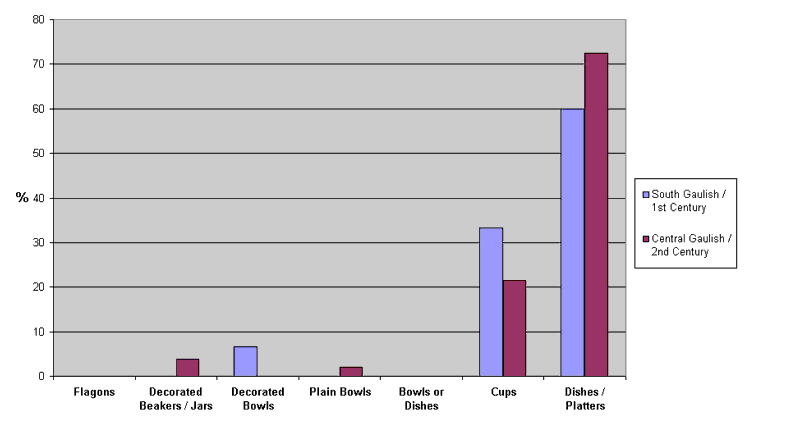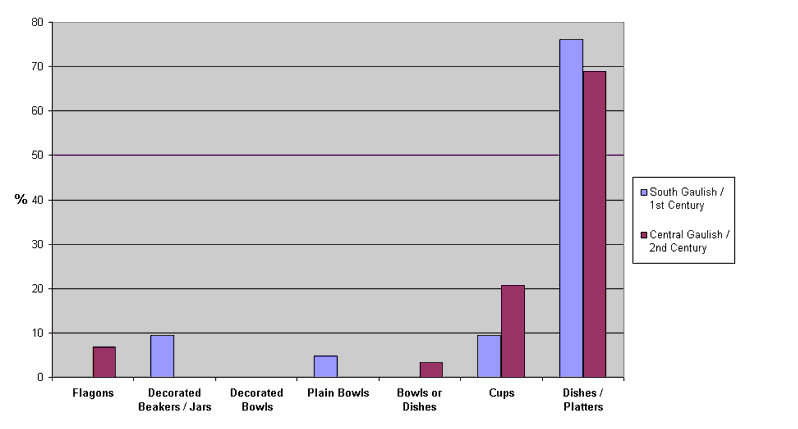There are nine cemetery environments relating to smaller civil settlements for which data on the incidence of samian have been collected. These comprise the Essex sites of Chequers Lane, Great Dunmow, Bouchernes farm, Elms farm, and the 'new cemetery', at Heybridge, Neatham in Hampshire, Baldock, Walls Field and Upper Walls Common, in Hertfordshire, Each End at Ash-next-Sandwich (Kent) and Stonepound, Hassocks, in West Sussex (Appendix 9.1). Samian vessels were present in 37 graves at these nine cemeteries, with a total of 68 samian vessels being represented. The composition of this sample of vessels is documented by source, form and generic/functional type in Table 62. There are 15 vessels from La Graufesenque amongst this group, 10 from Les Martres and 35 from Lezoux, with, overall, 48 from Central Gaulish sources. There are proportionally more 2nd century than 1st century items, which is consistent with the fact that sites of this category, including 'Small Towns' and roadside settlements became, generally, more prominent in the 2nd century. Again the La Graufesenque vessels comprise, more or less exclusively, cups and dishes/platters, though there is also one decorated bowl, being a Drag. 29 from Burial 6 at Walls Field, Baldock. Among the Central Gaulish vessels there are no decorated bowls represented, and again, as with the major civil centres, cups and dishes/platters predominate (Table 65). Two beakers occur in Central Gaulish fabrics. As with the samian from burials associated with major civil centres, it is clear that there was a widespread and enduring practice of including samian cups and dishes/platters within graves associated with smaller centres, but not decorated bowls nor plain bowls.

Chart 19: Samian Form Types in Burials associated with Smaller Civil Centres: their Relative Frequency (Data from Table 65; N = 66).
The composition of the 68 vessels comprising this 'group' is summarised by form in Chart 19 above. This chart emphasises the predominance of cups and dishes/platters as a grave inclusion at cemeteries of this category. Dishes/platters are, however, markedly much more frequent than cups, which differs from the near parity seen in the sample from cemeteries associated with major civil centres. In fact cups become less frequent as a grave good during the 2nd century.
Data on the incidence of samian in graves associated with rural sites/locations is available for 17 cemetery environments (cf. Appendix 9.1). These comprise: Bancroft, Bradford Peverell (the western link road), Preston (Jordan's Hill), Whitcombe, Knob's Crook, Woodlands, Little Waltham (2 Roman Road), Stanway (cremation at Enclosure 3), Upminster (Hunts Hill Farm), Alton, Chells (Boxfield Farm), Dartford (Priory Centre), Brighton (Kemp Town and Springfield Road), North Lancing (Crabtree Lane), Portslade (Fulking Corner and Victoria Rd) and Sompting (Marquis of Granby Inn). These cemetery environments occur in Buckinghamshire, Dorset, Essex, Hampshire, Hertfordshire, and East and West Sussex. Samian vessels were present in some 31 graves with a total of 57 vessels represented. The make-up of this sample of 57 vessels is recorded by source, form and generic/functional type in Table 63. There are no decorated bowls present from any source. Of the La Graufesenque vessels, Drag. 18 is by far the most common form. Two decorated beakers from this source occur, being examples of Déch 67 and Knorr 78; both come from graves in Dorset. Of note are the samian inkwell from a Conquest-period grave at Stanway near Colchester (Appendix 9.1) and a Ritterling 12 from an inhumation at Whitcombe, Dorset, which had evidently been refashioned as a lamp, an artefact type itself associated with burials (Aitken and Aitken 1990, 79; Appendix 9.1). This Ritt. 12 is the only vessel among this sample of 57 samian vessels from graves associated with rural sites/locations which is a bowl form, yet since it had been altered it was effectively no longer of this functional class. Considering the vessels from Central Gaul, once again these are dominated by cups and dishes (cf. Tables 63 and 66). Of considerable interest is the occurrence in two separate graves of examples of the rare flagon type Stanfield 67 (Stanfield 1929) from Central Gaul. Both examples come from Sussex, specifically the cremation groups from Springfield Road, Brighton (1877) and at Crabtree Lane, North Lancing (Appendix 9.1). Coarse ware flagons are, of course, well known as grave furnishings, and occasionally were employed as cinerary urns (cf. Philpott 1991). The flagon Stanfield 67 is a particularly distinctive and uncommon type, and a survey of its distribution demonstrates that it is closely associated with burials and structured deposits (cf. Section 12). A further example of the form, for instance (which is not part of the sample of 207 samian vessels from graves examined here), is reported from a gravel pit opposite Bouchernes Farm, Heybridge, Essex; this vessel, which is evidently complete, was found before 1927, and occurs in East Gaulish fabric and is dated as 3rd century; it is believed almost certainly to be from a burial associated with the adjacent Roman cemetery (Wickenden 1986, 55, fig. 26, no. 20; Appendix 9.1).

Chart 20: Samian Form Types in Burials associated with Rural Sites / Locations: their Relative Frequency (Data from Table 66; N = 50).
Chart 20 above shows clearly that cups are much less frequent among the samian vessels included in funerary deposits at rural sites and locations than is the case with cemeteries associated with major civil centres and smaller centres. Instead, dishes/platters are particularly common, accounting for around 75% of the South Gaulish samian vessels from rural burials and c. 70% of the vessels from Central Gaul. Again, therefore, there is a temporal continuity.
© Internet Archaeology
URL: http://intarch.ac.uk/journal/issue17/1/9.5.3_4.html
Last updated: Mon Mar 7 2005